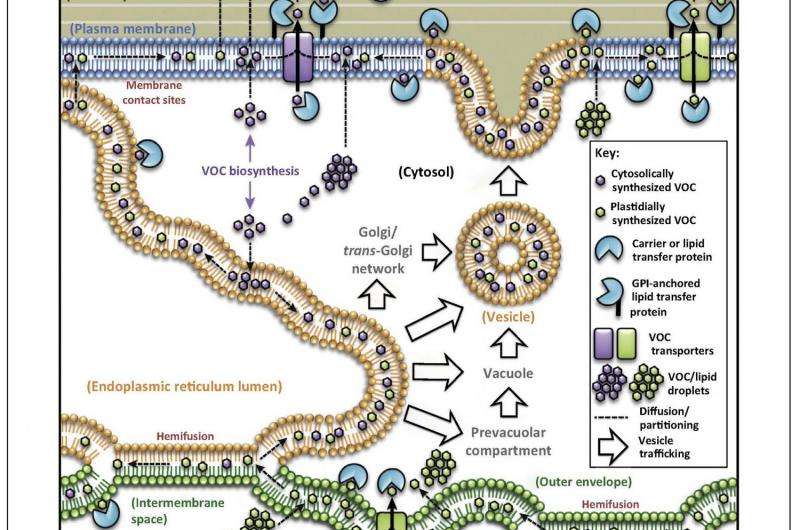Biology, not just physics, controls release of scent compounds from plants

Purdue University research suggests active biological mechanisms transport scent and taste compounds known as volatiles from plant cells to the atmosphere, a finding that could overturn the textbook model of volatile emission as a process that occurs solely by diffusion.
Volatiles play key roles in plant pollination, reproduction, defense and communication. Researchers thought volatiles diffused through the plant's porous outer cuticle once they built up in high concentrations inside the cell.
But a team led by Natalia Dudareva, distinguished professor of biochemistry and of horticulture and landscape architecture, found disparities between observed volatile release rates and the mathematics of the diffusion model. The researchers showed that toxic amounts of volatiles would accumulate in plant cell membranes if diffusion were the only mechanism at work in their release. They posited that biological mechanisms must also transport volatiles.
"It's practically impossible for simple diffusion to do this," Dudareva said. "Plants clearly need some molecular players to help get these compounds out of the cell. This is a completely new way to think about this important biological process."
Identifying the proteins and mechanisms involved in volatile emission could help researchers boost plant health and defenses, develop new ways to manage pests, engineer smells and flavors and control the timing and release of volatiles.

Flowers, leaves, stems and even roots can release volatiles, which perform many vital functions. They aid plant reproduction by attracting pollinators and seed dispersers. They help defend plants by attracting the natural enemies of plant-attacking pests and signaling to neighboring plants that herbivores or pathogens are nearby. Volatiles can also be used to make perfumes, food additives, preservatives, chemotherapeutics and anesthetics.
Volatiles must cross various barriers, an aqueous cell wall and the waxy cuticle or "skin" of the plant before they evaporate into the atmosphere as a gas that a human or bee can smell.
Because volatiles are small, it was reasoned that they could easily pass through pores in the cell wall and diffuse into the atmosphere, which has a low concentration compared with the interior of the cell. This process is based on a physical principle known as Fick's first law, which governs how molecules travel according to concentration gradients - for example, how the aroma of garlic spreads from an open jar to the other side of the room.
But the study indicates that volatile emission must involve more than physics, which generally dictates the way compounds are released, said John Morgan, professor of chemical engineering.
"Plants aren't burping," he said. "We're not saying diffusion doesn't happen, but it's not enough to describe the rates of volatile emission that we observe."
The researchers hypothesized that biological mechanisms actively lower volatile concentrations in membranes, which would also account for a problem unaddressed by the diffusion model: how volatiles, which are averse to water, can travel from their point of origin across the plant cell's water-based cytosol and aqueous cell wall. They proposed several methods for volatile transport based on how other hydrophobic compounds travel in the cell, including ferrying across the cytosol in the fatty layer of circular structures known as vesicles and traveling along networks of chutelike membranes.
Postdoctoral fellow and the study's first author Joshua Widhalm described volatile movement via intracellular membranes as "hitchhiking a ride to the cell's plasma membrane" where proteins then push the compounds through the cell wall to the cuticle."
This would rewrite the textbook on how this type of natural process occurs," he said.
More information: Rethinking how volatiles are released from plant cells, Trends in Plant Science, July 16, www.sciencedirect.com/science/ … ii/S1360138515001739.
Journal information: Trends in Plant Science
Provided by Purdue University


















